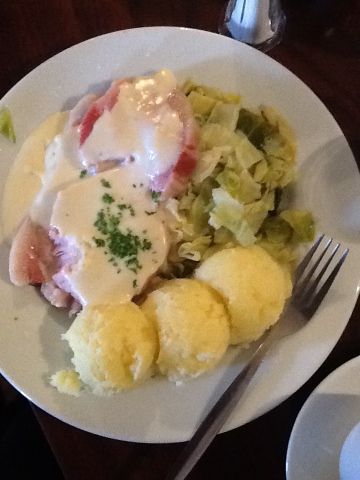These young people were going on a field trip, but happily obliged Dena's request to hold the WSU flag for a picture.
We first stopped at Bunratty Castle. We got to smell the beautiful aroma of traditional turf (peat) fire in a fireplace in a thatched cottage. Our guide showed us how the Big Irish families managed to sleep in such a small space, a bed settee, sort of Murphy bed for children. He said, "our neighbors all had big families, one had 18 children. For some reason there were only two in my family, and it's just something I'd never asked my mother, Bridget Mary, about, she would've knocked me in the head."







Throughout Ireland we saw gorgeous wool blankets and scarves. I loved the colors and actually bought some cute socks made from organically grown sheep at this shop near Bunratty Castle.
The Cliffs of Moher was our next stop.
A famous attraction and lovely opportunities for lots of pictures

 Back on the bus we go and get off for pictures at The Burren meaning "great rock",is a karst-landscape region or alvar in northwest County Clare, in Ireland. It is one of the largest karst landscapes in Europe. It's one of only six National Parks in Ireland. People are committed via the Burren Code to protect this landscape and remove no rocks. The pictures taken here are some of the best of the whole trip.
Back on the bus we go and get off for pictures at The Burren meaning "great rock",is a karst-landscape region or alvar in northwest County Clare, in Ireland. It is one of the largest karst landscapes in Europe. It's one of only six National Parks in Ireland. People are committed via the Burren Code to protect this landscape and remove no rocks. The pictures taken here are some of the best of the whole trip.  This picture is of a "famine" cemetery. History states that the Famine occurred because of a failure in the potato crop in Ireland. The Irish were under British occupation at the time. Rich landlords controlled the country, though they were a small portion of the population. Most of the population served as tenants to these landlords, and suffered from high rents and taxes. Poverty ran deep in the tenant class, which used the potato as the main staple of its diet. When the crop failed, panic set in. The Irish sold what they had, including boats and fishing equipment to feed their suffering families. One in three people died in the area surrounding Skibbereen. Most concur that there was plenty of food in Ireland – plenty enough to feed the starving citizens. But the food was exported for profit that was made by the British government and the Anglo Irish ruling class. People died suddenly and there was no way to have a proper burial so stones from the little church were used as headstone or grave markers.
This picture is of a "famine" cemetery. History states that the Famine occurred because of a failure in the potato crop in Ireland. The Irish were under British occupation at the time. Rich landlords controlled the country, though they were a small portion of the population. Most of the population served as tenants to these landlords, and suffered from high rents and taxes. Poverty ran deep in the tenant class, which used the potato as the main staple of its diet. When the crop failed, panic set in. The Irish sold what they had, including boats and fishing equipment to feed their suffering families. One in three people died in the area surrounding Skibbereen. Most concur that there was plenty of food in Ireland – plenty enough to feed the starving citizens. But the food was exported for profit that was made by the British government and the Anglo Irish ruling class. People died suddenly and there was no way to have a proper burial so stones from the little church were used as headstone or grave markers.
Our day ended in Galway and we drove by a monument erected after our President John F. Kennedy visited Galway on June 29, 1963, just four months before he died.
We only had about 90 minutes to dine, shop, or tour Galway and we were hungry so we tried to get into a well known pub called Taffe's, but it was packed with people so we ate instead at The Kings Head, received the royal treatment and had great food, but this is a better picture.
















No comments:
Post a Comment